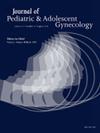52. 宫腔镜下宫内成形术在青少年和青壮年宫内节育器中的应用
IF 1.7
4区 医学
Q3 OBSTETRICS & GYNECOLOGY
引用次数: 0
摘要
背景:目前尚无关于宫腔镜下子宫成形术在青少年或青壮年(AYA)人群中的应用的已发表文献,也没有关于期望使用宫内节育器(IUD)的指征。我们的目的是描述该手术的使用情况,该手术历来用于生殖问题,在有子宫间隔的AYA中,由于痛经、避孕和大量月经出血(HMB)而需要插入宫内节育器。病例:所有患者在评估是否放置宫内节育器时均被诊断为子宫间隔,并接受过系统激素治疗或对激素治疗方案有医学限制。所有先前放置的宫内节育器均在手术前取出。所有的输卵管成形术均采用双极Twizzle Tip电极切开隔膜,所有患者在输卵管成形术时均简单放置了52微克的宫内节育器。一名15岁的痛经患者在联合激素治疗失败后,希望植入激素宫内节育器。她的子宫完全隔是通过超声检查后,弦乐检查引起了低放置宫内节育器的担忧。咨询后,她希望手术切除她的隔膜,以便有资格再次安置。在简单的中隔切除术和放置宫内节育器后,她在术后一个月的随访中没有任何不规则出血或盆腔疼痛的报告。17岁,因HMB和痛经就诊。病史包括幼年特发性关节炎和先兆偏头痛。在放置宫内节育器后,她接受了腹部成像以减轻体重,发现宫内节育器和子宫间隔放置不当。在反复咨询了可用的方法后,她坚持认为宫内节育器对她的月经管理是最好的。她接受了简单的中隔切除术和宫内节育器放置,并在两个月后随访,没有进一步的月经不适。25岁G1P0010患者,经痛经合并HMB,两种激素治疗方法均失败,放置宫内节育器后痛经加重。盆腔造影显示完整的子宫间隔,下半段分化为两个子宫颈。她接受了简单的切除和放置宫内节育器,并进行了腹腔镜检查以评估她的痛经。术后两个月,患者月经症状明显改善。评论:本病例系列强调了宫内节育器是各种妇科适应症的首选或唯一治疗选择的患者,特别是那些因副作用或共存疾病而无法使用其他激素治疗的患者,应考虑宫内节育器成形术的重要性。本文章由计算机程序翻译,如有差异,请以英文原文为准。
52. Hysteroscopic metroplasty for use of intrauterine devices in adolescents and young adults
Background
There is no published literature on the use of hysteroscopic metroplasty in an adolescent or young adult (AYA) population, nor for the indication of desired intrauterine device (IUD) usage. We aimed to describe the usage of this procedure, which has historically been performed for reproductive concerns, in AYA with uterine septa who desired IUD insertion for dysmenorrhea, contraception, and heavy menstrual bleeding (HMB).
Case
All patients presented were diagnosed with a uterine septum when evaluating for a possible malpositioned IUD, and had either trialed systemic hormone management or had medical restrictions on hormonal treatment options. All previously placed IUDs were removed prior to surgical management. All metroplasties were performed using a bipolar Twizzle Tip electrode to incise the septum and all patients had uncomplicated placement of a 52-mcg IUD at time of metroplasty. A 15-year-old G0 with dysmenorrhea desired a hormonal IUD after failing combined hormonal methods. Her complete uterine septum was diagnosed via ultrasound after a string check raised concerns for a low-lying IUD. After counseling, she desired surgical removal of her septum to be eligible for repeat placement. After uncomplicated septum resection and IUD placement, she was seen for a one month post-operative visit without any reported irregular bleeding or pelvic pain. A 17-year-old G0 presented for HMB and dysmenorrhea. Her medical history included juvenile idiopathic arthritis and migraines with aura. After IUD placement, she underwent abdominal imaging for a weight loss work-up that noted a malpositioned IUD and uterine septum. After repeat counseling on available methods, she maintained that an IUD was best for her menstrual management. She underwent an uncomplicated septum resection and IUD placement, and was seen for follow-up at two months without further menstrual complaints. A 25-year-old G1P0010 with dysmenorrhea and HMB, with failure of two hormonal methods, had worsening dysmenorrhea after IUD placement. Pelvic imaging revealed a complete uterine septum with divergence of the lower segment into two separate cervixes. She underwent uncomplicated resection and IUD placement, as well as a laparoscopy to evaluate her dysmenorrhea. She was seen two months post-operatively with a significant improvement in menstrual symptoms.
Comments
This case series highlights the importance of metroplasty as a consideration for patients for whom an IUD is the preferential or only treatment option for a variety of gynecologic indications, especially for those unable to use other hormonal therapies secondary to side effects or co-existing conditions.
求助全文
通过发布文献求助,成功后即可免费获取论文全文。
去求助
来源期刊
CiteScore
3.90
自引率
11.10%
发文量
251
审稿时长
57 days
期刊介绍:
Journal of Pediatric and Adolescent Gynecology includes all aspects of clinical and basic science research in pediatric and adolescent gynecology. The Journal draws on expertise from a variety of disciplines including pediatrics, obstetrics and gynecology, reproduction and gynecology, reproductive and pediatric endocrinology, genetics, and molecular biology.
The Journal of Pediatric and Adolescent Gynecology features original studies, review articles, book and literature reviews, letters to the editor, and communications in brief. It is an essential resource for the libraries of OB/GYN specialists, as well as pediatricians and primary care physicians.

 求助内容:
求助内容: 应助结果提醒方式:
应助结果提醒方式:


